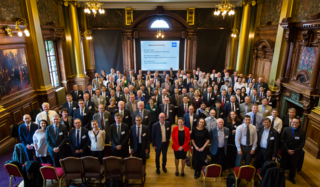Related Research Articles

The International Organization for Standardization is an independent, non-governmental, international standard development organization composed of representatives from the national standards organizations of member countries. Membership requirements are given in Article 3 of the ISO Statutes.
IEC 61850 is an international standard defining communication protocols for intelligent electronic devices at electrical substations. It is a part of the International Electrotechnical Commission's (IEC) Technical Committee 57 reference architecture for electric power systems. The abstract data models defined in IEC 61850 can be mapped to a number of protocols. Current mappings in the standard are to Manufacturing Message Specification (MMS), GOOSE [see section 3, Terms and definitions, term 3.65 on page 14], SV or SMV, and soon to web services. In the previous version of the standard, GOOSE stood for "Generic Object Oriented Substation Event", but this old definition is still very common in IEC 61850 documentation. These protocols can run over TCP/IP networks or substation LANs using high speed switched Ethernet to obtain the necessary response times below four milliseconds for protective relaying.
ISO/IEC 20000 is the international standard for IT service management. It was developed in 2005 by ISO/IEC JTC1/SC7 and revised in 2011 and 2018. It was originally based on the earlier BS 15000 that was developed by BSI Group.
Information security standards or cyber security standards are techniques generally outlined in published materials that attempt to protect the cyber environment of a user or organization. This environment includes users themselves, networks, devices, all software, processes, information in storage or transit, applications, services, and systems that can be connected directly or indirectly to networks.
The ISO/IEC 27000-series comprises information security standards published jointly by the International Organization for Standardization (ISO) and the International Electrotechnical Commission (IEC).
ISO/TC 176 is Technical Committee 176 of the International Organization for Standardization (ISO), responsible for Quality management and quality assurance - the ISO 9000 family of standards.

ISO/TC 292 Security and resilience is a technical committee of the International Organization for Standardization formed in 2015 to develop standards in the area of security and resilience.
The Annex SL is a section of the ISO/IEC Directives part 1 that prescribes how ISO Management System Standard (MSS) standards should be written. The aim of Annex SL is to enhance the consistency and alignment of MSS by providing a unifying and agreed-upon high level structure, identical core text and common terms and core definitions. The aim being that all ISO Type A MSS are aligned and the compatibility of these standards is enhanced.